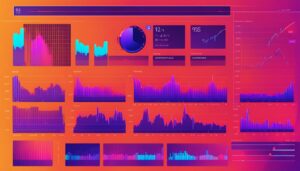In this comprehensive guide, I will provide you with an ultimate cheat sheet for trading order types. Understanding different order types is crucial for executing effective trading strategies. We will explore market orders, limit orders, stop orders, stop limit orders, trailing stop orders, good till cancelled (GTC) orders, and one cancels other (OCO) orders. By mastering these order types, you will gain better control over your trades and improve your overall trading performance.
Key Takeaways:
- Trading order types are essential for executing effective trading strategies.
- Market orders allow for fast execution but offer no control over execution price.
- Limit orders provide control over execution price but execution is not guaranteed.
- Stop orders help manage risk and offer automatic trade execution.
- Stop limit orders combine stop orders and limit orders for risk management and price control.
Market Orders
A market order is a type of trading order that is executed immediately at the current market price. It ensures quick execution, which is crucial in fast-moving markets. Market orders offer fast execution and a high probability of trade execution. However, they come with the disadvantage of no control over the execution price and potential slippage.
| Advantages | Disadvantages |
|---|---|
| Fast execution | No control over execution price |
| High probability of trade execution | Potential slippage |
Limit Orders
A limit order is an essential trading order type that provides traders with control over the execution price of their trades, offering a valuable tool for effective trading strategies. With a limit order, you can specify the price at which you want to buy or sell an asset, ensuring that your trade is executed at that specific price or even better.
This level of control over the execution price sets limit orders apart from other order types, such as market orders. Unlike market orders, which are executed immediately at the current market price, limit orders allow you to define the desired price for your trade, providing a higher level of precision and strategy.
“Limit orders provide traders with control over the execution price and eliminate the risk of slippage.”
One of the key advantages of limit orders is the elimination of slippage risk. Slippage refers to the discrepancy between the expected price of a trade and the actual price at which it is executed. This can occur due to market volatility or rapid price movements. By setting a specific price for your trade with a limit order, you can minimize the possibility of slippage and ensure that you enter or exit a position at your desired price.
It’s important to note, however, that execution is not guaranteed with limit orders. Since the market may not reach the specified price, your limit order might not be executed immediately. In such cases, patience may be required to wait for the price to reach your desired level. This tradeoff between price control and guaranteed execution is a crucial consideration when using limit orders in your trading strategy.
To illustrate the benefits of limit orders further, let’s consider an example:
| Order Type | Execution Price | Slippage Risk |
|---|---|---|
| Market Order | Current Market Price | High |
| Limit Order | Specified Price or Better | No Slippage |
As shown in the table above, market orders offer fast execution but come with the risk of slippage. On the other hand, limit orders provide control over the execution price and eliminate slippage risk. Understanding these trade-offs and selecting the appropriate order type is crucial for achieving your trading goals.

By utilizing limit orders, traders can take advantage of market movements while executing trades at their desired prices. This order type empowers traders with the ability to implement specific trading strategies and manage risk effectively.
Next, we will delve into another important order type in the world of trading: stop orders. These orders play a vital role in risk management and automating trade execution.
Stop Orders
A stop order, also known as a stop-loss order, is an essential tool in risk management for traders. It allows you to set a specific price level, known as the stop price, at which you want to buy or sell an asset.
When the market price reaches or falls below the stop price for a sell order, or reaches or rises above the stop price for a buy order, the stop order is triggered. This automatic trade execution feature ensures that you can quickly exit a position if the market moves against you, protecting your capital and minimizing potential losses.
Stop orders are widely used in various trading strategies, including day trading and swing trading, to manage risk effectively. They provide traders with a disciplined approach to risk management by taking emotions out of the decision-making process.
However, it’s important to note that stop orders do not guarantee execution at the specified stop price. In highly volatile markets or during fast price movements, the actual execution price may deviate from the stop price, resulting in slippage. Slippage occurs when the execution price is different from the expected price, and it can impact the profitability of the trade.
Despite the potential for slippage, stop orders remain a crucial tool for traders who prioritize risk management and automatic trade execution. By using stop orders effectively, traders can protect their capital and limit potential losses.
Advantages of Stop Orders:
- Automatically exits a position if the market moves against you, minimizing potential losses
- Allows for risk management and improved trade execution
- Provides a disciplined approach to trading
Disadvantages of Stop Orders:
- No control over the execution price, potentially leading to slippage
- Execution at the stop price is not guaranteed in highly volatile markets
| Advantages | Disadvantages |
|---|---|
| 1. Automatically exits a position if the market moves against you, minimizing potential losses | 1. No control over the execution price, potentially leading to slippage |
| 2. Allows for risk management and improved trade execution | 2. Execution at the stop price is not guaranteed in highly volatile markets |
| 3. Provides a disciplined approach to trading |
Stop Limit Orders
A stop limit order is a powerful tool that combines the features of a stop order and a limit order. It allows traders to have greater control over their trades by setting a specific price at which they want to buy or sell an asset.
When the stop price is reached, the order automatically converts into a limit order. This means that the trade will only be executed at the specified limit price or better. It offers traders the advantage of controlling the execution price, providing a level of price control that stop orders alone do not offer.
Stop limit orders are particularly useful for managing risk. Traders can set a stop price to protect themselves from significant losses and a limit price to ensure they secure a favorable entry or exit price. This combination of risk management and price control helps traders implement their trading strategies effectively.
However, it is important to note that execution is not guaranteed with stop limit orders. The market conditions may not reach the specified limit price, resulting in the trade not being executed. Traders need to carefully consider these factors and set their stop limit orders accordingly.
Example:
Let’s say you are long on a stock that is currently trading at $50 per share. You want to protect your gains and limit your potential losses. You set a stop limit order with a stop price of $48 and a limit price of $47.
If the stock price reaches $48, your stop limit order is triggered, converting it into a limit order. However, if the stock price drops below $47, your order will not be executed, and you will remain in the trade.
Stop limit orders provide traders with an effective risk management tool that allows for greater price control. However, it is essential to carefully consider market conditions and set realistic stop and limit prices to increase the chances of trade execution.
| Advantages | Disadvantages |
|---|---|
|
|
Conclusion
Understanding different order types is essential for executing trading strategies effectively. Whether you’re engaged in day trading or swing trading, having a grasp of various order types can provide you with the flexibility and control you need to optimize your trades.
Market orders offer fast execution, while limit orders allow you to have control over the execution price. Stop orders help manage risk by automatically executing trades when the price reaches a specified level. Stop limit orders combine the features of stop orders and limit orders, providing both risk management and price control.
Additionally, trailing stop orders, GTC orders, and OCO orders provide even more flexibility in managing your trades. By familiarizing yourself with these order types and their respective advantages and disadvantages, you can enhance your overall trading performance and gain better control over your investments.
FAQ
What is a market order?
A market order is a type of trading order that is executed immediately at the current market price. It offers fast execution and a high probability of trade execution, but there is no control over the execution price and potential slippage may occur.
What is a limit order?
A limit order is an order to buy or sell at a specific price or better. It provides control over execution price and eliminates the risk of slippage. However, execution is not guaranteed, and it may require patience to get the desired price.
What is a stop order?
A stop order, also known as a stop-loss order, is an order to buy or sell once the price reaches a specified level, known as the stop price. Stop orders help manage risk by automatically exiting a position if the market moves against you. However, there is no control over the execution price, and potential slippage may occur.
What is a stop limit order?
A stop limit order combines the features of a stop order and a limit order. Once the stop price is reached, the order becomes a limit order to buy or sell at the specified limit price or better. It offers a combination of risk management and price control, but execution is not guaranteed, and setting up these orders may be more complex.
Why is understanding different order types important for trading strategies?
Understanding different order types is essential for executing trading strategies effectively. Market orders, limit orders, stop orders, stop limit orders, trailing stop orders, GTC orders, and OCO orders provide flexibility and control in executing trades. Each order type has its own advantages and disadvantages, allowing traders to adapt their strategies to market conditions and manage risk.





